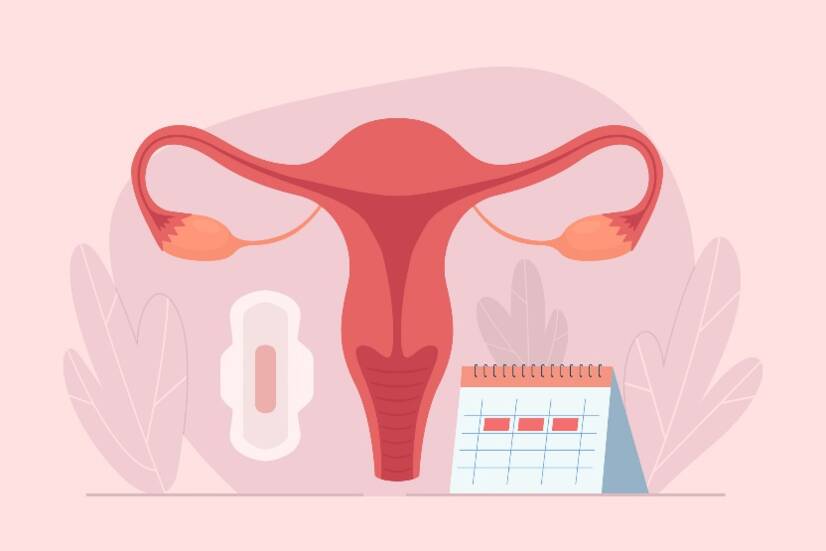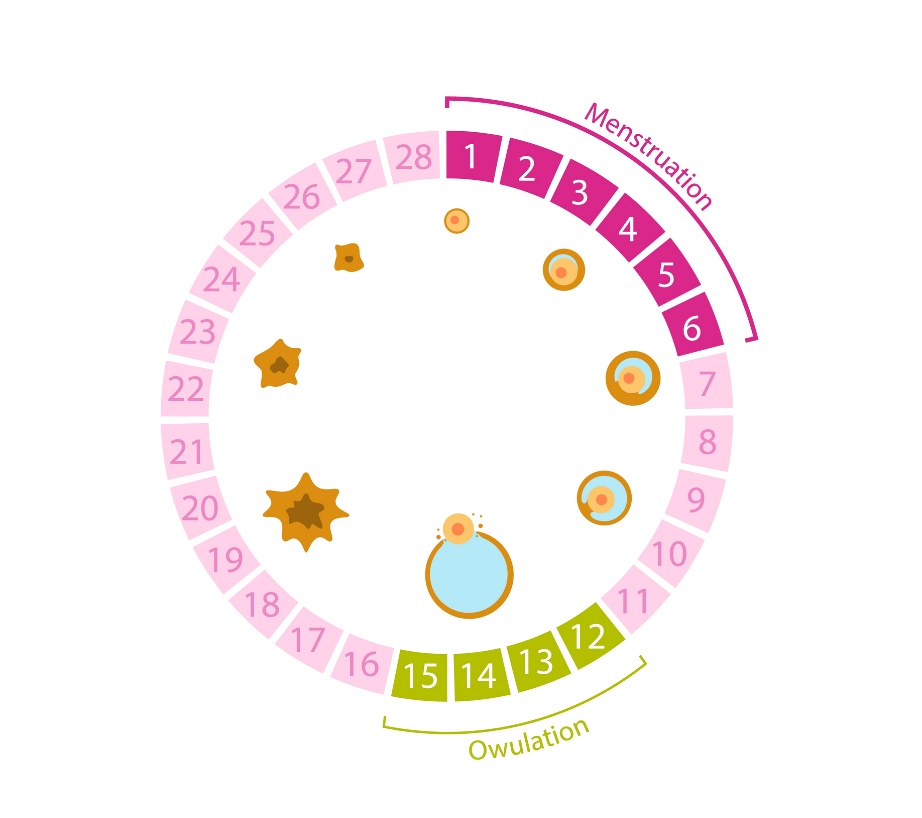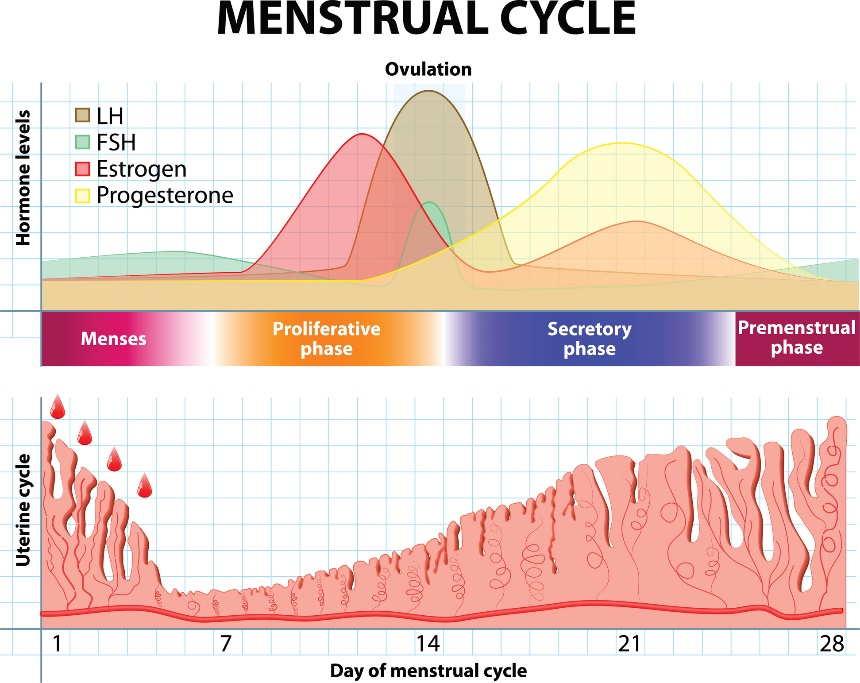- ROZTOČIL, Aleš and Pavel BARTOŠ. Modern Gynaecology. Prague: Grada, 2011. ISBN 978-80-247-2832-2
- ROB, Lukáš, Alois MARTAN and Pavel VENTRUBA. Gynecology. Third, supplemented and revised edition. Prague: Galén, [2019]. ISBN 978-80-7492-426-2
- solen.sk - Menstrual cycle disorders. Solen. doc. MUDr. Soňa Kiňová, PhD.
- healthline.com - Stages of the Menstrual Cycle. Healthline. Stephanie Watson
How does the menstrual cycle work? Cycle length and phases + symptoms

The menstrual cycle is part of the physiological functioning of the female reproductive and hormonal system. How does the cycle work, what are its four phases and manifestations?
Article content
The course of a woman's cycle, its phases, length, hormone levels, symptoms and many other interesting information can be found in the article.
What is the menstrual cycle?
The menstrual cycle, professionally called eumenorrhea, is a hormonal physiological cycle in the female body. The cycle is also referred to as the ovarian cycle. It runs from puberty to the advanced age of menopause.
The average cycle length is 28 days.
The cycle has 4 basic phases. It is considered to begin with menstruation. The cycle then ends with the beginning of the next menstrual period.
The basic function of the menstrual (ovarian) cycle is to prepare the female sex cells of the egg and the uterine lining for fertilization. Menstruation, or menstrual bleeding, is the short phase of the ovarian cycle that occurs after the egg has not been fertilized.
The time when women menstruate and have a functional menstrual cycle is referred to as the fertile period.
A woman menstruates for approximately 40 years of her life.
During the menstrual cycle, the levels of the female hormones estrogen and progesterone change physiologically.
Menstruation (menses) is characterized by physiological vaginal bleeding that recurs approximately every month. Menstrual blood enters the uterus from the uterus through a small opening in the cervix and then leaves the body through the vagina.
Menstrual bleeding lasts approximately 5 to 7 days.
Accompanying symptoms of the onset of menstruation may be increased breast tenderness, uterine muscle contractions, lower abdominal pain, bloating, increased fatigue, changes in mood or appetite.
Cycle length and regularity
A menstrual cycle lasts approximately 28 to 30 days. A shorter 21-day cycle is considered physiological, as is a longer 35-day cycle.
The length of the menstrual cycle can vary from month to month.
Some women have an exactly regular cycle and can predict the exact day and time of menstruation. Other women with regular menstruation can only predict its arrival with a variation of a few days.
Menstrual bleeding lasts an average of 5 days. Physiological bleeding is considered to be 2-8 days. Blood loss is approximately 20 to 80 ml.
The regularity of the arrival of menstruation, ovulation, and the overall length of the cycle is influenced by a number of internal and external environmental factors.
The following factors affect the regularity and length of the cycle:
- The age of the woman
- Exposure to stress factors
- Lifestyle and physical activity
- Significant weight change
- Pharmacological treatment
- Current diseases and inflammation in the body
- Hormonal imbalances
- Diseases of the reproductive system
See a doctor (gynecologist) if:
- Menstrual cycle is less than 21 days
- Menstrual cycle is longer than 35 days
- Menstrual bleeding lasts longer than 8 days
- Menstruation is delayed by 5 weeks or more
- Blood loss is greater than 100 ml
- Menstrual pain is excessive and unbearable
- You experience bleeding outside the menstrual phase
- You are unsure of some of the signs and symptoms of your cycle
First menstrual period
Thefirst menstrual period is technically called menarche. It occurs around the age of 10 to 15 during puberty. The average age of first menstruation is 13 years. Menstruation ends between 45 and 55 years of a woman's life.
In the past, in different cultures, a girl's first bleeding meant that she was ready to conceive a child and thus become a woman.
Throughout life, menstruation changes gradually. At puberty, menstruation can vary in intensity and irregularity. However, gradually with age, the cycle becomes more regular in length and frequency.
The timing of the onset of the first menstrual period is related to age, lifestyle, dietary habits, production of the hormone estrogen, and adipose tissue.
4 phases of the menstrual cycle
A woman's ovulatory cycle is divided into 4 basic parts (phases). The periods of menstruation and ovulation are considered opposite peaks of the cycle.
- Menstrual phase (menstruation)
- Follicular phase
- Ovulatory phase (ovulation)
- Luteal/luteinization phase

1. Menstrual phase
The physiological menstrual phase lasts 2-7 days and its main manifestation is menstrual vaginal bleeding of up to 80 ml. The female body gets rid of unnecessary tissue of the uterine lining, the unfertilized egg along with the blood.
During menstruation, it is necessary to pay attention to increased hygiene and regular replacement of menstrual hygiene products. Mild pain in the lower abdomen caused by contractions of the uterine muscles is typical.
The onset of menstruation may be accompanied by breast tenderness, indigestion and a deterioration in mental status. At this stage of the cycle, women are often moody and melancholic with a tendency to depression.
In the menstrual phase, the level of female hormones is at a minimum. Increased fatigue is present and therefore it is advisable to indulge in more rest.
2. Follicular phase
Menstruation is followed by the follicular phase, named after FSH - follicle-stimulating hormone. By secreting FSH, a fertile egg develops in the woman's ovary in the so-called follicle - envelope.
The phase is characterised by increased production of oestrogen and LH (luteinising hormone). The follicle produces oestrogens which gradually prepare the uterine lining for the eventual fertilisation of the egg.
The follicular phase lasts approximately 6 days.
The woman is usually positive, energetic and sociable.
3. Ovulatory phase
When the egg in the follicular phase has fully matured, the ovulation phase begins. The body produces estrogen and luteinizing hormone, which causes the egg to be released from the ovary.
The moment the egg travels from the ovary through the fallopian tube into the uterus, ovulation is triggered.
Ovulation takes place approximately mid-cycle, on days 12-14 of the 28-day menstrual cycle. Ovulation lasts 24-48 hours.
Ovulation is often accompanied by mild pain in the lower abdomen. It is characterized by the presence of a watery cervical discharge - mucus coming from the cervix that facilitates the male sperm's movement and path to the female egg.
It is the ovulatory phase that is most important in terms of pregnancy. The mature egg is capable of fertilisation approximately 24 hours after release. The levels of the hormones oestrogen, FSH and LH are at their maximum.
The ovulatory cycle takes place alternately in one of the two ovaries during the menstrual cycle in the fertile period of a woman's life. The ovary contains a number of immature eggs before birth, which gradually mature over the course of a woman's life.
During the ovulation phase, women tend to be creative, productive with increased libido and sex drive.
4. Luteal/luteinization phase
The last phase of the cycle and the phase preceding menstruation is the luteal part of the cycle. This phase usually lasts no longer than 16 days. There is a decrease in estrogen levels and, conversely, an increase in progesterone levels.
The ruptured follicle in the ovary turns into a yellow corpus producing large amounts of the hormone progesterone, which helps the uterine lining to grow to better hold a potentially fertilized egg.
If fertilization of the egg does not occur, after the end of the luetal phase, the egg dies, the basal temperature drops along with the progesterone level and menstruation starts again. The cycle begins again.
A woman may experience various physical and psychological symptoms during this phase as her hormone levels change, called PMS - premenstrual syndrome.
The most common symptoms of PMS are mood changes and swings, irritability, excessive fatigue, headaches, breast tightness and tenderness, lower abdominal pain, acne or digestive problems.

Overview of hormones affecting the menstrual cycle
Ovarian hormones
Estrogens - Estradiol, estrone and estriol are hormones formed in the ovaries. Their main function is to enlarge the uterine lining for better ovulation and to promote ovulation.
Hormones affect the menstrual cycle and the regularity of menstruation. Estrogens improve mental state and mood by increasing levels of the hormone serotonin and endorphins.
Estrogen is a hormone that acts mainly in the first half of the cycle and at ovulation.
At puberty it is important in the formation of secondary female sex characteristics (growth of breasts, hips, pubic hair...). It has a positive effect on the sex drive and libido of a woman.
Gestagens - Progesterone is formed in the corpus luteum in the ovary after ovulation. Its main function is to transform the lining of the uterus so that it is able to receive the fertilized egg.
Gestagens have the opposite psychological effect to estrogens. They cause premenstrual syndrome.
If a male sperm successfully fertilizes an egg, progesterone stops the menstrual cycle. During pregnancy and lactation, gestagens are the dominant hormone.
Progesterone is a hormone that acts mainly in the second half of the cycle.
Testosterone and androgen - Popularly called male hormones, but they are also important in the female body. They are formed in the ovaries and adrenal glands. They cause an increase in libido and have a positive effect on bone metabolism and psychological state.
Pituitary hormones
The pituitary gland (hypothalamus) is an endocrine gland of the brain that controls the thyroid, adrenal glands and gonads (ovaries in women). The pituitary hormones that control and influence the gonads are technically called gonadotropins.
FSH (follicle-stimulating hormone) - its function is to stimulate the cells of the ovary to produce estrogens and androgens. It promotes the formation of follicles - the envelopes of the eggs. The level of this hormone also tells about the sheer number of eggs in the ovaries.
LH (luteinizing hormone) - its function is to stimulate the ovary to produce androgens, which are then converted into estrogens. It stimulates the production of testosterone. Its increased level of LH induces ovulation and its action turns the follicle into a corpus luteum.
Prolactin - its function is to stimulate the mammary gland to produce breast milk. It influences and regulates other sex hormones.

Important concepts and knowledge about the female cycle
Premenstrual syndrome
PMS is characterized by a set of physical and psychological manifestations before and at the onset of menstruation. The etiology of onset is related to hormonal changes and a significant hormonal decline in the luteal phase of the cycle.
Physical symptoms may include lower abdominal pain and cramping, bloating, indigestion, headache, migraine, increased breast tenderness and fullness, change in appetite, excessive fatigue, insomnia and general physical weakness.
Psychological symptoms include frequent mood changes, irritability, anxiety, melancholy, decreased concentration and ability to concentrate.
Ovulation and fertile days
Ovulation is the brief period of time when a mature egg leaves the ovary and travels to the uterus. It is the most likely time to become pregnant if a woman has had unprotected intercourse.
The close period around the day of ovulation is called the fertile window - fertile days.
Male sperm can survive in a woman's reproductive organs for 3 to 5 days, while a woman's egg lives for 12 to 24 hours after ovulation.
Ovulation (the most fertile day of the menstrual cycle) occurs approximately in the middle of the cycle (day 14). The fertile window and fertile days are approximately between days 12 and 16 of the cycle.
- Ovulation, calculation of fertile and infertile days. How to plan pregnancy?
- Date of childbirth: How to calculate the most accurate date of childbirth?
Menopause and menopause
A woman menstruates for approximately 40 years of her life. Most women have regular menstrual periods until menopause - the period when there is a gradual transition to menopause.
Climacterium, popularly called transition, is a period when the body's hormonal activity gradually declines. The ovaries gradually stop producing female sex hormones and the ability of the ovaries to mature eggs is extinguished.
According to the World Health Organization (WHO), the menopause period begins approximately one year before menopause.
Menopause is a condition where a woman has not received a period for 12 months (1 year) straight. The average age of menopause is 52 years, with a range of approximately 45-55 years.
Thus, a woman transitions from the fertile period to the period of reproductive dormancy.
Menstruation and pregnancy
Since fertilization of the egg and conception of the baby has occurred, the woman's ovarian cycle will be subdued during this time. The disappearance of menstruation is one of the basic signs of pregnancy.
However, from a biological point of view, pregnancy begins as soon as the egg has nested in the lining of the uterus. It may initially be accompanied by light bleeding. If menstrual-like bleeding occurs during pregnancy, it is necessary to visit a gynaecologist for professional help.
Menstrual cycle disorders
In the fertile period, a woman may encounter various pathologies of the menstrual cycle. When abnormal symptoms, pain and various ambiguities are noted, it is advisable to seek professional help from a gynecologist to determine the cause of its occurrence.
Examples of common menstrual cycle disorders of various etiologies:
- Dysmenorrhea - excessively painful menstruation accompanied by nausea, painful cramps in the lower abdomen and digestive problems
- Hypermenorrhea - excessively heavy and intense bleeding
- Hypomenorrhoea - bleeding that is too light, with a normal cycle length
- Menorrhagia - heavy intense and prolonged menstrual bleeding at the same time
- Amenorrhoea - the omission of menstruation and absence of bleeding
- Polymenorrhoea - too frequent recurrence and shortening of the menstrual interval below 21 days
- Oligomenorrhoea - infrequent bleeding at longer intervals over 35 days
- Abnormal vaginal bleeding - bleeding that occurs at an inadequate time outside the menstrual cycle (< 21 or > 36 days after the last menstrual period)
Promoting healthy and regular menstruation
A healthy menstrual cycle is manifested by regularity, cyclicity, presence of ovulation and menstruation. Menstruation is long and intense within the physiological range, with mild pain and PMS symptoms.
Prevention starts from the basics such as quality sleep, eliminating stress and avoiding poor eating and exercise habits.
Diet greatly influences the course of menstruation. Before the onset of menstruation, it is advisable to increase the dietary intake of magnesium, potassium, iron, vitamins B1, B6, D and E. During menstruation, care should be taken to increase iron intake as well.
For menstrual comfort, natural herbal teas and extracts in dietary supplements containing "female herbs" can be supplemented to promote menstrual comfort and cycle support.
Regular annual visits to the gynaecologist, including sonography/mammography of the breasts and a cervical smear for laboratory examination, are essential for professional prevention.
Prevention of a healthy menstrual cycle:
- Regular annual preventive visits to the gynaecologist
- Not delaying a visit to the gynecologist when health problems arise
- Regular compensatory physical activity
- Exercises to activate and relax the pelvic floor
- Elimination of muscular imbalances of the pelvic area
- Elimination of stress factor
- Quality regular sleep
- Elimination of alcohol and tobacco consumption
- Natural help of herbs (herbal tea, extract from dietary supplements)
- Diet with sufficient mineral content (especially magnesium, potassium, zinc, calcium and iron)
- Diet with sufficient vitamins (especially B, D and E)
- Elimination of excessive consumption of refined sugar
- Adequate regular intake of protein in the diet
Interesting resources
Related










